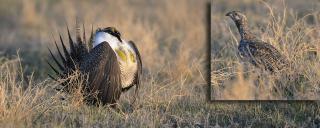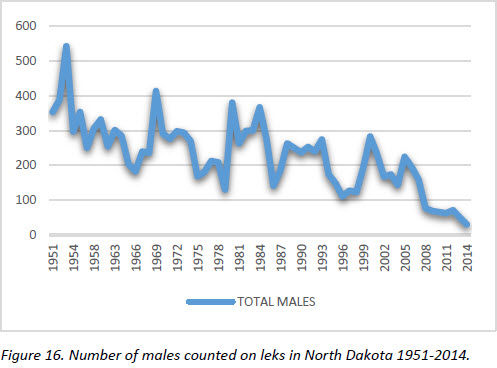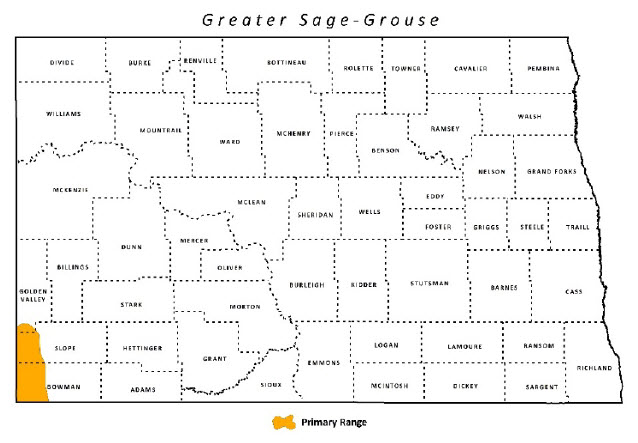
Greater Sage Grouse
| Scientific Name | Centrocercus urophasianus |
|---|---|
| General Description | L 28”, WS 38”, 6.3 lb. The largest of North American grouse species, males are dark brown overall with white breast, pointed tail, and yellow above eye. |
| Status | Year-round resident. Peak breeding season late April to mid-July. |
| Abundance | Uncommon. |
| Primary Habitat | Big sagebrush ecosystem. |
| Federal Status | Candidate species under the Endangered Species Act. |
| Reason for Designation | This species range has contracted substantially in North Dakota. It once occurred east of the Little Missouri River, now believed vanished from there. This species is declining nationwide. Partners in Flight (PIF) identifies the Greater Sage- Grouse as a Regional Concern and Stewardship Species, U.S.-Canada Concern and Stewardship Species, and a Tri-national Concern Species. |
Locations and Conditions of Key Habitat
Preferred Habitat
Primarily associated with sagebrush, particularly big sagebrush. Silver sagebrush and rabbitbrush is utilized to a lesser extent. Riparian and upland meadows, irrigated and non-irrigated croplands and pasturelands are also used, especially for broodrearing habitat. Leks may be natural openings within a sagebrush community or created by disturbance such as dry stream bed channels, ridges, grassy meadows, burned areas, gravel pits, plowed fields, and roads. Nest under larger bushes generally within 1.5-3 km of the lek. Brood-rearing habitat should contain succulent herbaceous vegetation such as false dandelion, hawksbeard, milkvetch, and insects such as grasshoppers. Rely nearly exclusively on big sagebrush for food during winter.
Key Areas and Conditions for Greater Sage-grouse in North Dakota
Most active and inactive leks have been identified and only occur in far southwestern North Dakota. These leks and the surrounding area (within 2 km) should be of top priority.
Problems Which May Affect this Species
Habitat
The destruction and/or degradation of sagebrush throughout North America is negatively affecting this species and is the biggest threat. The quality of remaining sagebrush has declined due to grazing, fire suppression or excessive fire, invasion of exotic plants, and other human-related degradation.
Other Natural or Manmade Factors
Disturbance to leks and nesting sites from direct and indirect human activity is of great concern. Recent research in Wyoming indicates sage grouse may lack resistance to West Nile virus. Most, but not all, research suggests that hunting does not have an impact on sage grouse populations. Mortality such as birds flying into electric wires, fences, utility wires, and being hit by automobiles occur.
Research and Survey Efforts
Current Research or Surveys
- The North Dakota Game and Fish Department conducts annual lek surveys counting the number of birds present.
Previous Research or Surveys
- Peripheral microhabitat and landscape characteristics were compared to identify possible reasons for lek abandonment in North Dakota in 2001 and 2002.
- Nesting and brood-rearing habitat selection of Greater Sage- Grouse, and associated survival of hens and broods, seasonal movements and autumn-winter habitat selection of Greater Sage-Grouse in North Dakota.
- Numerous published reports and gray literature throughout the species range.
Additional Research or Surveys Needed
Contact the North Dakota Game and Fish Department Upland Game Biologists for most current information needs.
Population and Trend Estimates

- PIF Global Population Estimate: 150,000
- North Dakota 2014 Census: 31 males
- North Dakota Male Population Goal: 250
- North Dakota Lek Survey Trend: see figure 16
- Survey-wide BBS Trend 1966-2012: -2.36
Management Recommendations
- Protect existing big sagebrush stands through easements or land acquisition.
- Include big sagebrush when reclaiming croplands and grassland restoration.
- Do not burn big sagebrush habitat, and rehabilitate previously burned sites.
- Encourage or provide incentives for land management practices that provide for maintaining or enhancing sage grouse habitat through livestock grazing management.
- Avoid constructing fences through or near leks and install visibility markers to existing fences.
- Remove single trees that serve as raptor perches.
- Utility development should follow the guidance of “Reducing Avian Collisions with Power Lines” including marking power lines and creating an Avian Protection Plan.
Monitoring Plans
According to the Partners in Flight Landbird Conservation Plan, long-term population trend monitoring such as the Breeding Bird Survey produces imprecise trends for this species. No additional monitoring is needed at this time as the NDGFD will continue in the lead role of obtaining population date on Greater Sage-Grouse.
2005-2015 Progress
The Greater Sage-Grouse remains a Level I Species of Conservation Priority. The species is in imminent danger of being extirpated from North Dakota.

Note: A listing of works consulted when compiling the information on this page may be found in the 2015 State Wildlife Action Plan.
